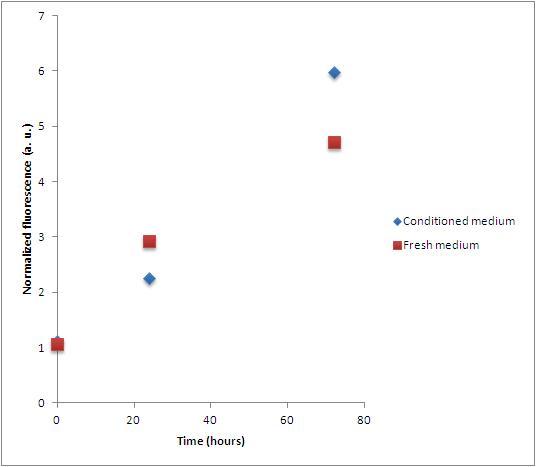Team:Buenos Aires/ hybrid
From 2013.igem.org
FedeVignale (Talk | contribs) (→Hybrid promoter induction and repression) |
FedeVignale (Talk | contribs) (→Hybrid promoter induction and repression) |
||
| Line 26: | Line 26: | ||
According to the results, the hybrid promoter (Bba_K145150) can be induced by HSL-LuxR. However, fresh medium mRFP curve suggests a high basal transcription from this promoter. | According to the results, the hybrid promoter (Bba_K145150) can be induced by HSL-LuxR. However, fresh medium mRFP curve suggests a high basal transcription from this promoter. | ||
| + | |||
| + | |||
| + | |||
| + | == '''Future experiment: Hybrid promoter repression''' == | ||
| + | |||
| + | |||
| + | '''Objective''' | ||
| + | |||
| + | Characterize the repression of the hybrid promoter by c2 repressor. | ||
| + | |||
| + | '''Method''' | ||
| + | |||
| + | A culture of Rhizobium leguminosarum will be grown overnight (ON), in TY medium, at 30°C. Besides, a culture of E. coli co-transformed with BBa_K1106000 and the P22 C2 phage repressor under control of an arsenite inducible promoter (Bba_K1106012) will also be grown ON, at 37°C, in LB with the appropriate antibiotic. As a positive control, a Chromobacterium violaceum culture will be grown at 30°C in LB medium. | ||
| + | |||
| + | Afterwards, the three cultures will be centrifuged. E. coli and Chromobacterium violaceum culture’s supernatants will be discarded and the pellets resuspended in Rhizobium leguminosarum culture’s supernatant, containing HSL, which would induce mRFP expression in E. coli, and violacein expression in Chromobacterium violaceum. Moreover, E. coli culture will be split in two tubes with different arsenite concentrations (0 ppb and 1000 ppb). | ||
| + | Cultures will then be grown for 72 hours, and aliquots will be taken at 0, 24 and 72 hours of induction. Finally, bacteria will be sonicated and fluorescence measured, normalized by cell growth (OD 600nm). | ||
| + | |||
</div> | </div> | ||
Revision as of 00:14, 28 September 2013
Hybrid promoter induction and repression
Hybrid promoter induction
Objective
Characterize the response of the hybrid promoter to the HSL/LuxR inducer complex.
Method
A culture of Rhizobium leguminosarum was grown overnight (ON), in TY medium, at 30°C. Besides, a culture of E. coli carrying a plasmid that encodes mRFP under a hybrid promoter inducible by the Lux system of Vibrio fischeri , and repressible by the phage repressor P22 C2 (Bba_K1106000) was also grown ON, at 37°C, in LB with the appropriate antibiotic. As a positive control, a Chromobacterium violaceum culture was grown at 30°C in LB medium.
Afterwards, the three cultures were centrifuged. E. coli (DH5α strain) and Chromobacterium violaceum culture’s supernatants were discarded and the pellets were resuspended in Rhizobium leguminosarum culture’s supernatant, containing HSL, which would induce mRFP expression in E. coli, and violacein expression in Chromobacterium violaceum.
Cultures were then grown for 72 hours, and aliquots were taken at 0, 24 and 72 hours of induction. Finally, bacteria were sonicated and fluorescence measured, normalized by cell growth (OD 600nm).
Results
A mayor fluorescence production can be seen in the culture induced with AHL, compared with the one whithout induction.
Conclusions
According to the results, the hybrid promoter (Bba_K145150) can be induced by HSL-LuxR. However, fresh medium mRFP curve suggests a high basal transcription from this promoter.
Future experiment: Hybrid promoter repression
Objective
Characterize the repression of the hybrid promoter by c2 repressor.
Method
A culture of Rhizobium leguminosarum will be grown overnight (ON), in TY medium, at 30°C. Besides, a culture of E. coli co-transformed with BBa_K1106000 and the P22 C2 phage repressor under control of an arsenite inducible promoter (Bba_K1106012) will also be grown ON, at 37°C, in LB with the appropriate antibiotic. As a positive control, a Chromobacterium violaceum culture will be grown at 30°C in LB medium.
Afterwards, the three cultures will be centrifuged. E. coli and Chromobacterium violaceum culture’s supernatants will be discarded and the pellets resuspended in Rhizobium leguminosarum culture’s supernatant, containing HSL, which would induce mRFP expression in E. coli, and violacein expression in Chromobacterium violaceum. Moreover, E. coli culture will be split in two tubes with different arsenite concentrations (0 ppb and 1000 ppb). Cultures will then be grown for 72 hours, and aliquots will be taken at 0, 24 and 72 hours of induction. Finally, bacteria will be sonicated and fluorescence measured, normalized by cell growth (OD 600nm).
 "
"
